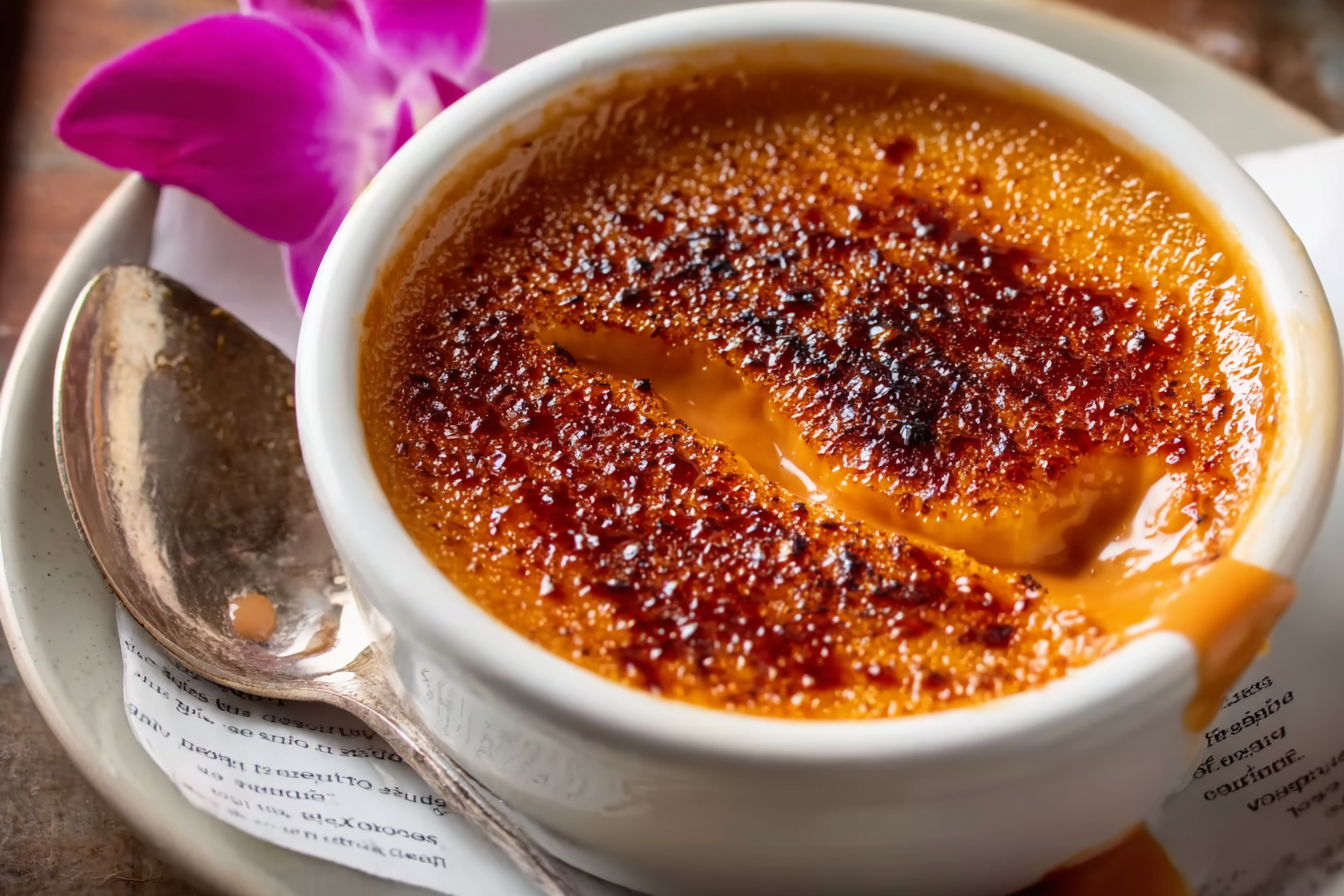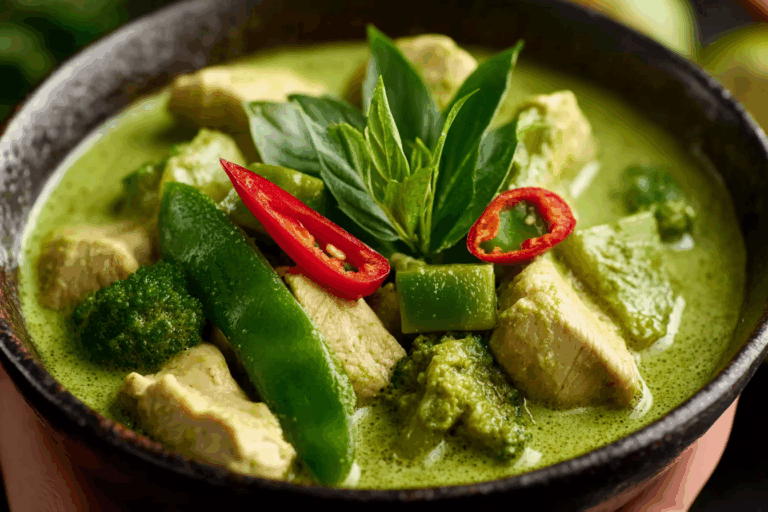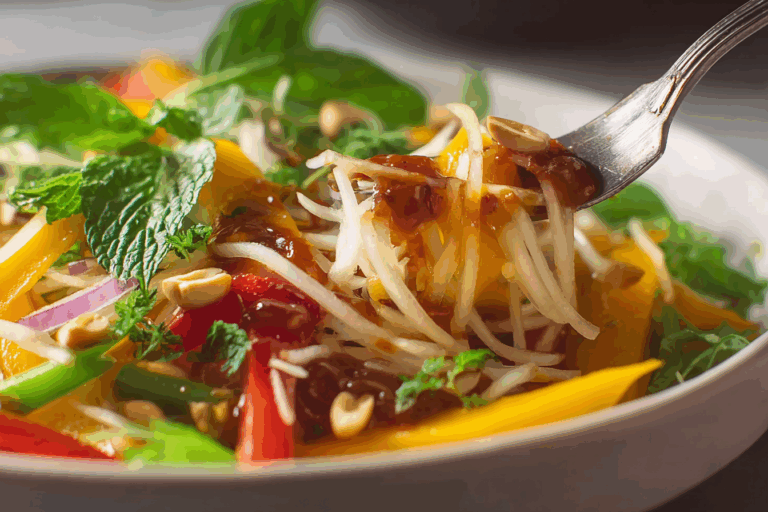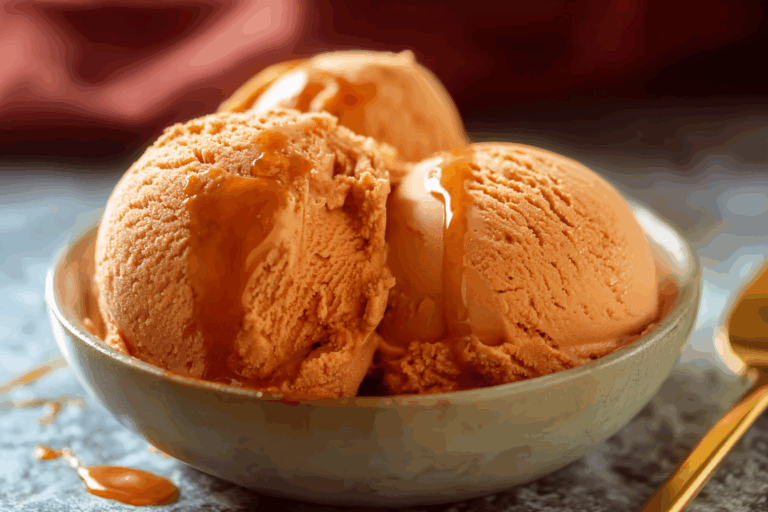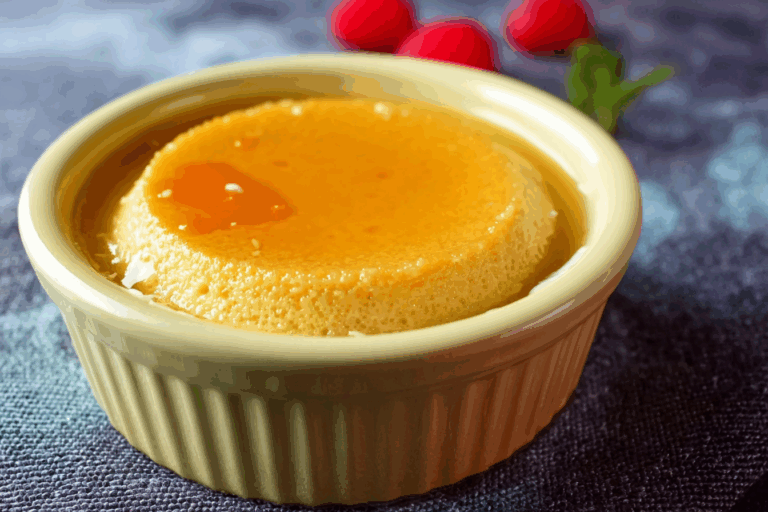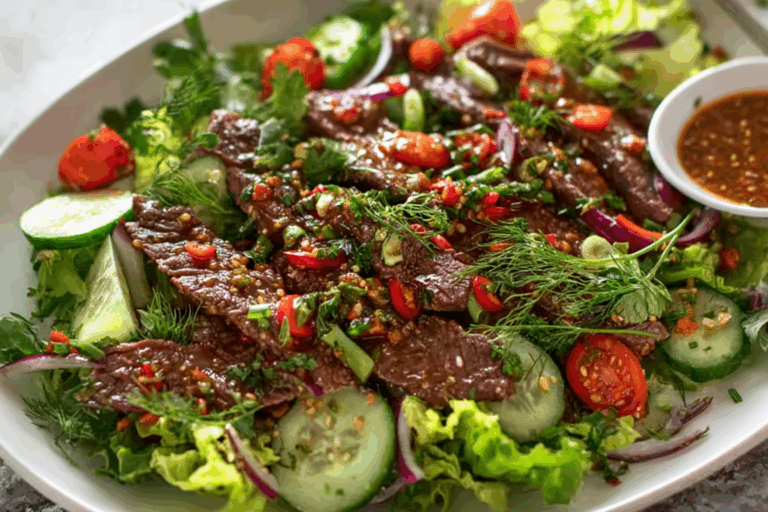Thai Tea Crème Brûlée Recipe That Will Blow Your Mind
Thai Tea Crème Brûlée isn’t just another dessert—it’s a mouthwatering masterpiece that combines the comforting richness of classic French custard with the bold, aromatic character of Thai tea. Imagine that creamy, delicate base infused with deep orange hues, topped with a crunchy caramel crust that shatters with the tap of a spoon. That’s what you get with this Thai-fusion treat.
At Just Thai Recipes, our mission is to share Thai food that speaks to the soul—and this recipe is no exception. As explained on our About page, Lina, the creator of this site, began her journey by fusing Thailand’s unforgettable flavors with everyday meals. Her goal? To take traditional recipes and add a bold, new twist. Thai Tea Crème Brûlée is one of those twists—a creamy, exotic dessert that blends technique with tradition.
In this article, we’ll walk you through everything: a step-by-step Thai Tea Crème Brûlée recipe, ingredient breakdown, baking tips, creative variations, pairing suggestions, and answers to the most commonly asked questions. Whether you’re a home baker looking to impress or a Thai food lover on the hunt for your next favorite dessert, you’re in the right place.
Check out Thai Coconut Custard Better Than Any Restaurant Dessert to explore another creamy Thai creation.
Table of Contents
Table of Contents
Understanding Thai Tea Crème Brûlée
What Is Thai Tea Crème Brûlée?
Thai Tea Crème Brûlée is a flavorful twist on the classic French dessert. The original crème brûlée is a baked custard topped with caramelized sugar, but this Thai version is steeped with authentic Thai tea mix, giving it a rich, amber hue and a more robust flavor. It’s not just about taste—it’s a visual showstopper, too.
The custard is smooth, silky, and infused with the warm, spiced, slightly floral notes of Thai tea. The torched sugar topping adds the perfect contrast, offering a light crunch to balance the creamy filling. This dessert delivers a full sensory experience—sweet aroma, bold color, creamy texture, and the satisfying crack of caramel on top.
Why Thai Tea Changes the Game
Regular crème brûlée relies on vanilla as its primary flavor, but Thai Tea Crème Brûlée elevates the custard to new heights. Thai tea mix—usually made with strongly brewed black tea, star anise, crushed tamarind, and sometimes cardamom—introduces a bold, earthy flavor with subtle spicy undertones.
When infused into heavy cream, the tea’s natural orange tint creates a dramatic dessert with deeper complexity. Instead of just sweet and creamy, you get sweet, creamy, spiced, and aromatic—a flavor profile that lingers long after the last bite.
This balance makes it more than just a dessert—it’s a flavor memory. Whether served at dinner parties or savored on quiet evenings, Thai Tea Crème Brûlée always leaves an impression.
Print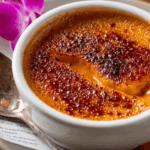
Thai Tea Crème Brûlée
- Prep Time: 30 minutes
- Cook Time: 40 minutes
- Total Time: 1 hour 10 minutes plus chilling time
- Yield: 4 servings 1x
- Category: Dessert
- Method: Baking
- Cuisine: Fusion
- Diet: Vegetarian
Description
This Thai Tea Crème Brûlée is a fusion twist on the classic French dessert, featuring the aromatic and bold flavor of Thai tea steeped into a rich, creamy custard and finished with a caramelized sugar crust.
Ingredients
- 2 cups heavy cream
- 3 tbsp Thai tea mix
- 5 egg yolks
- 1/2 cup granulated sugar
- 1 tsp vanilla extract
- 2 cups hot water (for water bath)
Instructions
- Microwave the heavy cream for 1 minute. Add the Thai tea mix and steep for 20 minutes.
- Preheat the oven to 325°F (160°C).
- Strain the tea-infused cream through a fine mesh sieve. Heat until hot but not boiling.
- In a separate bowl, whisk together the egg yolks and sugar until smooth.
- Temper the eggs by slowly whisking in 1/4 cup of the hot cream. Then combine the tempered eggs into the rest of the cream mixture and stir until smooth.
- Add vanilla extract and stir. Remove from heat.
- Place 4 ramekins into a 9×9 baking dish. Ladle the custard mixture through a fine mesh sieve into the ramekins.
- Pour 2 cups of hot water into the baking dish to create a water bath.
- Bake for 35-40 minutes, checking at 35 minutes. The custard should jiggle slightly like jello when done.
- Cool at room temperature for 2 hours, then chill overnight in the refrigerator.
- Before serving, sprinkle a thin layer of sugar over the top of each custard. Torch the sugar with a kitchen torch until caramelized.
Notes
- Use a kitchen thermometer if unsure about custard doneness; it should reach around 170–175°F.
- Thai tea mix may stain – steep and strain carefully.
- Let the ramekins cool completely before refrigerating to avoid condensation on top.
Nutrition
- Serving Size: 1 ramekin (8 oz)
- Calories: 410
- Sugar: 28g
- Sodium: 40mg
- Fat: 34g
- Saturated Fat: 21g
- Unsaturated Fat: 11g
- Trans Fat: 0g
- Carbohydrates: 30g
- Fiber: 0g
- Protein: 5g
- Cholesterol: 265mg
Keywords: Thai Tea Crème Brûlée, Thai Tea Dessert, Asian fusion dessert, homemade crème brûlée, Thai tea custard
Ingredients and Equipment Guide
Thai Tea Crème Brûlée Ingredients (Authentic & Simple)
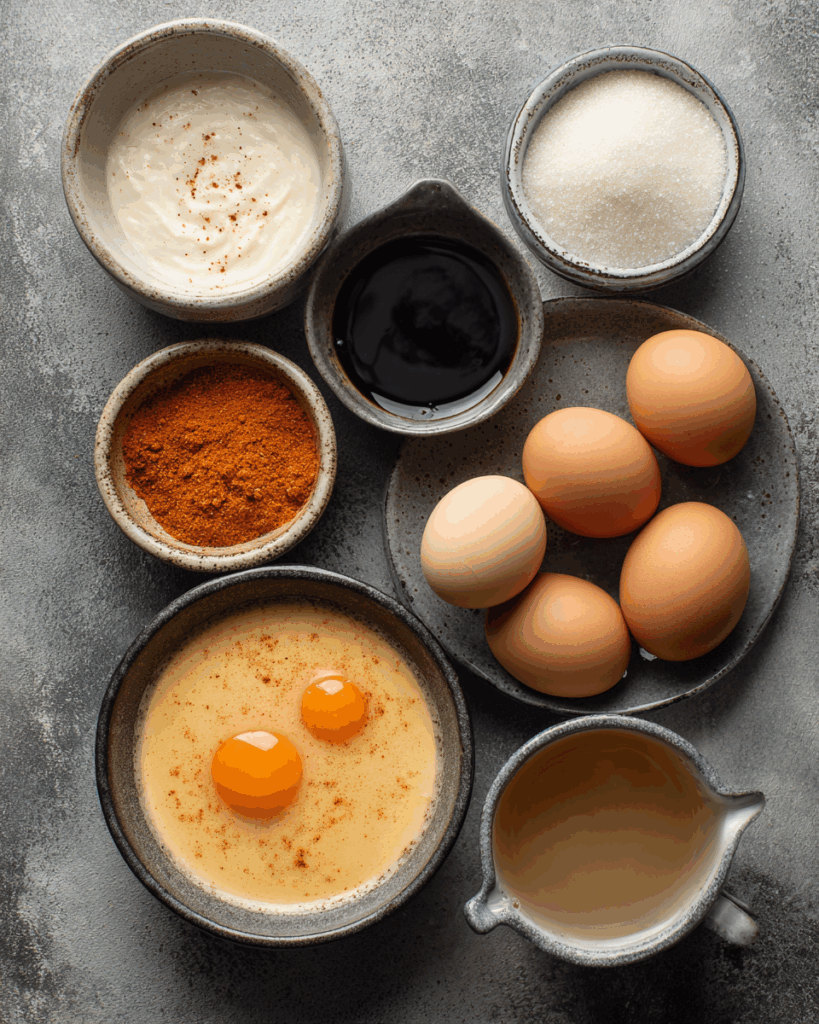
Creating an unforgettable Thai Tea Crème Brûlée starts with sourcing the right ingredients. The quality and balance of each component are critical to achieve the smooth texture and the bold Thai flavor this dessert is known for.
Here’s a full list of the ingredients you’ll need:
| Ingredient | Quantity | Purpose |
|---|---|---|
| Heavy Cream | 2 cups | Forms the creamy base of the custard |
| Thai Tea Mix | 3 tbsp | Infuses flavor and gives the dessert its iconic orange color |
| Egg Yolks | 5 | Provides richness and thickens the custard |
| Granulated Sugar | ½ cup | Sweetens the custard and is also used to brûlée the top |
| Vanilla Extract | 1 tsp | Adds a fragrant base note and smooths the tea’s boldness |
| Hot Water | 2 cups | Used to create a water bath for gentle baking |
Let’s break each ingredient down:
- Heavy Cream: The heart of crème brûlée. It delivers the rich, creamy mouthfeel. Use high-quality heavy cream for the best results—avoid light cream or milk, which will yield a watery custard.
- Thai Tea Mix: This is a blend of strongly brewed black tea, often mixed with star anise, orange food coloring, and sometimes spices like cardamom and tamarind. It’s essential for that signature Thai tea flavor and vibrant color. Popular brands include Pantai or Number One Thai Tea Mix.
- Egg Yolks: The yolks act as a natural thickener. They set up during baking to form that silky, spoonable custard. Be sure to separate them cleanly to avoid adding egg whites, which could affect the texture.
- Granulated Sugar: Half goes into the custard to sweeten it. The rest is reserved for caramelizing on top, creating that classic crunchy “crack” with a kitchen torch.
- Vanilla Extract: Enhances both the sweetness and complexity of the tea. Vanilla smooths out bitter edges and makes the flavor more rounded.
- Hot Water: Used to create a bain-marie, or water bath, which prevents the custard from cooking too quickly and curdling. It ensures even heat distribution for a creamy finish.
Ingredient Substitutions (If Needed)
While it’s best to use the exact ingredients, here are acceptable substitutions:
- No heavy cream? Use full-fat coconut cream for a dairy-free version.
- No Thai tea mix? Brew strong black tea (like Ceylon) and infuse with crushed star anise and a pinch of cardamom.
- Low on sugar? Coconut sugar can be used, but it will darken the custard.
Optional Garnishes
- Crushed Thai basil
- Toasted coconut flakes
- A swirl of Thai tea caramel (for added presentation)
Looking for inspiration? Try our Thai Coconut Pancakes: How To Make The Sweetest Dessert to add a side treat to your dessert table.
Essential Equipment to Make Thai Tea Crème Brûlée
Using the right tools ensures success, especially for a custard-based dessert that relies on precision.
| Tool | Purpose |
|---|---|
| Ramekins (4 x 8oz) | Individual portion baking vessels for custards |
| Oven Thermometer | Ensures oven accuracy, vital for consistent texture |
| Fine Mesh Sieve | Strains out tea leaves and prevents lumps in custard |
| Kitchen Torch | Caramelizes the sugar topping evenly |
Let’s walk through why each is important:
- Ramekins: Classic crème brûlée is baked in ceramic ramekins to help control the heat and serve neat portions. Choose 6-8 oz sizes for the best ratio of custard to caramel top.
- Oven Thermometer: Many ovens run hot or cold, which can result in curdled or undercooked custard. A thermometer ensures your oven truly hits that 325°F sweet spot.
- Fine Mesh Sieve: After steeping, the tea leaves and any clumps need to be filtered out to keep the custard silky smooth. It’s also used when ladling custard into ramekins.
- Kitchen Torch: A must-have. It allows precise caramelization of the sugar without reheating the custard underneath. If you don’t have one, use your oven broiler carefully, but the results won’t be as evenly crisp.
Bonus Equipment:
- Baking dish (9×9 or larger): For holding the ramekins during baking.
- Kettle or saucepan: For heating water for the water bath.
Check out Thai Red Rubies Dessert – The Most Delicious Thai Sweet for another recipe that uses unique Thai ingredients in a show-stopping way.
Step-by-Step Thai Tea Crème Brûlée Recipe
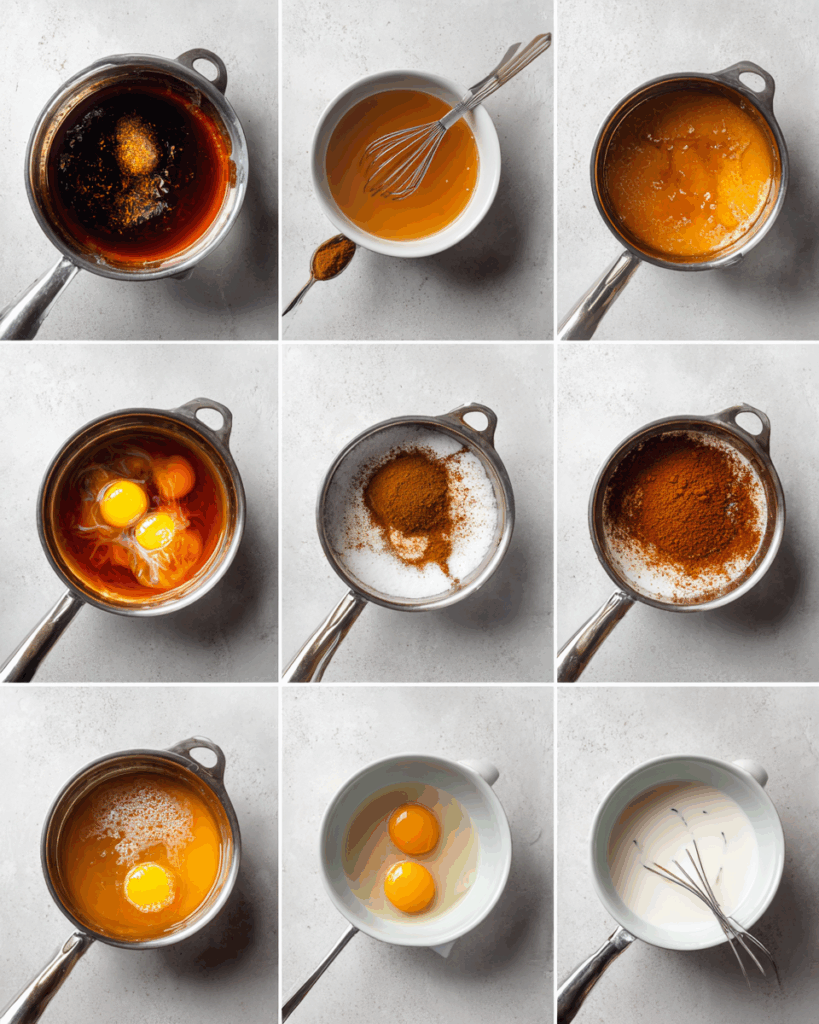
Creating the perfect Thai Tea Crème Brûlée may sound intimidating, but with a structured approach and attention to detail, you’ll find the process both enjoyable and rewarding. Below is the complete, step-by-step method inspired by Hot Thai Kitchen, Jaja Bakes, and the restaurant-style method shared by Nan Thai Fine Dining.
Step 1: Infuse the Cream with Thai Tea
Start by making your infused cream base. This is the key to unlocking the deep amber color and signature flavor.
- Heat the Cream
Microwave or gently warm 2 cups of heavy cream in a saucepan until steaming but not boiling. Boiling cream can alter the fat structure, so stay just below that point. - Steep the Tea
Add 3 tablespoons of Thai tea mix to the hot cream. Stir, cover, and steep for 20 minutes. This step allows the black tea and spices to fully infuse the cream with their flavor and color. - Strain the Mixture
After steeping, pour the cream through a fine mesh sieve into a clean bowl to remove tea leaves and prevent graininess in the final custard.
Tip from Jaja Bakes: Strain a second time for a smoother consistency. The smallest tea particles can affect your texture if not fully filtered.
Step 2: Make the Egg-Sugar Mixture
In a separate bowl:
- Whisk 5 egg yolks and ½ cup granulated sugar
Beat until the mixture turns pale and smooth. This means the sugar has begun dissolving, which results in a better mouthfeel. - Add Vanilla Extract
Mix in 1 teaspoon of vanilla extract to enhance the custard’s base flavor and balance the boldness of the Thai tea.
Note: The quality of your eggs makes a big difference. Use fresh, free-range egg yolks for the best flavor and color.
Step 3: Temper the Egg Yolks
Tempering prevents the eggs from scrambling when introduced to hot liquid:
- Slowly pour ¼ cup of the warm Thai tea cream into the egg mixture while whisking constantly.
- Once incorporated, gradually mix in the rest of the cream. Whisk gently to avoid air bubbles.
Tip from Hot Thai Kitchen: Tempering is crucial—pour slowly and whisk thoroughly. Don’t rush this step.
Step 4: Fill and Prepare for Baking
- Place 4 ramekins in a 9×9-inch baking dish.
- Pour the custard through the sieve again (for extra smoothness) into each ramekin, filling almost to the top.
- Carefully add 2 cups of hot water into the baking dish to form a water bath (bain-marie) around the ramekins. This regulates the temperature during baking and prevents cracking or curdling.
Pro Tip from Nan Thai Fine Dining: Cover ramekins loosely with foil to avoid excess browning while baking.
Step 5: Bake to Perfection
- Preheat your oven to 325°F (163°C).
- Bake the custards for 35 to 40 minutes, checking at 35. You’re aiming for a slightly wobbly center—like Jell-O.
- If they jiggle uniformly, they’re done. If the center sloshes like liquid, bake an additional 2–5 minutes.
Remove ramekins from the water bath and let cool to room temperature for 2 hours. Then refrigerate overnight (or at least 6 hours) to allow the custard to fully set.
Step 6: Torch the Sugar Crust
- Once chilled, sprinkle 1 to 1½ teaspoons of granulated sugar evenly over each custard.
- Using a kitchen torch, melt and caramelize the sugar. Move the flame in small, circular motions to avoid burning spots. The sugar should bubble, darken, and harden into a shiny, crisp shell.
- Let sit for 1–2 minutes before serving. This allows the sugar to harden fully.
Don’t have a torch? Use the broiler in your oven, placing ramekins on the top rack for 1–2 minutes. Watch closely to prevent burning.
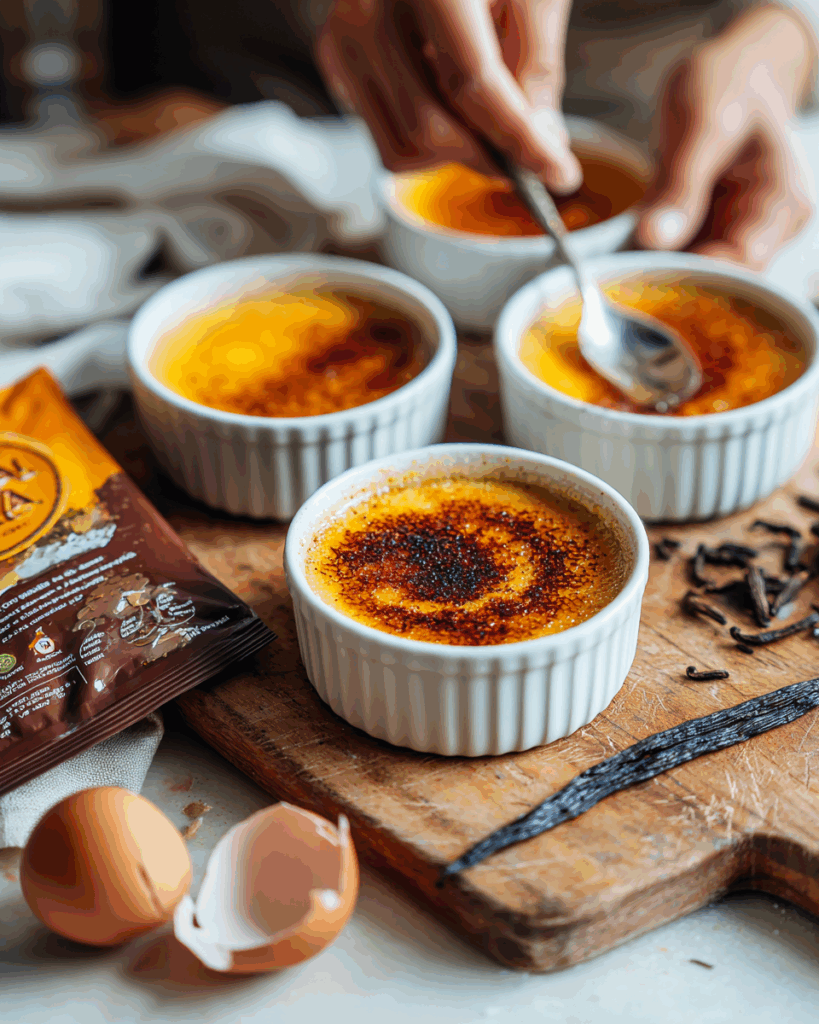
Bonus Tips from Thai Chefs
- Nan Thai Fine Dining recommends using a small amount of salt in the cream to deepen flavor. Just a pinch can amplify the sweetness.
- Jaja Bakes suggests refrigerating the baked custard uncovered to avoid condensation.
- Hot Thai Kitchen emphasizes serving immediately after torching for the most satisfying caramel crunch.
Your Thai Tea Crème Brûlée is now ready to be served. It’s creamy, bold, aromatic, and delicately sweet with that satisfying sugar crunch on top—a flawless blend of French elegance and Thai flavor.
What Makes This Thai Tea Crème Brûlée So Delicious?
The moment your spoon cracks through the glossy sugar crust and glides into that creamy Thai tea custard, you know you’re not eating just any dessert. This isn’t an ordinary crème brûlée. It’s an exotic transformation of flavor, texture, and color that creates a memorable culinary experience.
Let’s break down exactly why Thai Tea Crème Brûlée is so irresistible.
The Cream in Thai Tea: What It Really Is
Traditional Thai tea is famous for its vibrant orange color and smooth, rich taste. A big part of that comes from the creamy component typically added to it. In Thai iced tea, that’s usually sweetened condensed milk, evaporated milk, or sometimes half-and-half. These give Thai tea its signature sweetness and velvety finish.
But in Thai Tea Crème Brûlée, the cream is elevated to a whole new level. Instead of just adding milk, the tea is steeped directly into heavy cream—a higher-fat dairy product. Why? Because heavy cream creates a silkier custard with a luxurious mouthfeel and a more balanced richness that doesn’t overwhelm the earthy notes of the tea.
This use of heavy cream allows the tea’s floral and spicy notes to come through clearly, while also giving the dessert its creamy texture that defines every great crème brûlée.
Why the Flavor Profile Stands Out
Thai tea brings a depth of flavor that vanilla alone can’t match. While traditional crème brûlée is subtle and simple, Thai Tea Crème Brûlée offers complexity and character. Here’s how the flavors work together:
- Earthiness from black tea creates a bold base
- Warm spice notes (from star anise and tamarind in the mix) give it dimension
- Floral undertones from the tea itself offer delicate balance
- Sweet cream and sugar round everything out with richness
This unique combination delivers a layered flavor journey in every spoonful. It starts off sweet and creamy, then the spice peeks through, and finally, the bitterness of the tea lingers—refreshing and bold.
Visual and Textural Appeal
You eat with your eyes first, and Thai Tea Crème Brûlée doesn’t disappoint. The custard’s bright orange hue immediately signals something different and exciting. It’s colorful, inviting, and instantly recognizable.
But once you dig in, the real magic is in the texture. The contrast between the silky custard and the crisp caramel crust is everything:
- The top cracks with a tap, releasing the aroma of burnt sugar
- The custard underneath is cool, smooth, and creamy
- Each bite is a play between warm, cold, hard, and soft
It’s that dynamic texture—hot sugar and cold custard, crunchy top and creamy base—that keeps you coming back for more.
Cultural Fusion at Its Best
Beyond flavor and texture, there’s something inherently special about a dessert that brings two culinary traditions together. Thai Tea Crème Brûlée is a culinary fusion—a marriage of France’s refined elegance and Thailand’s bold vibrancy. This makes it both familiar and exotic, comforting and adventurous.
It’s also versatile. It can be served after a fancy dinner or be the highlight of a casual potluck. It’s simple to make but tastes like it came from a fine dining restaurant.
The Aromatics: Why It Smells As Good As It Tastes
Open a container of Thai tea mix and you’ll immediately notice its strong scent—earthy, almost woody, with hints of vanilla and spice. These aromatic qualities don’t fade during baking. In fact, they intensify.
When the custard is steeped with Thai tea, those volatile oils in the tea leaves release into the cream. During baking, they evolve into deep, comforting aromas that fill your kitchen. When you finally torch the sugar, the caramel scent joins the mix, creating a sensory experience that’s hard to beat.
The Psychological Factor: Nostalgia and Novelty Combined
There’s also an emotional element. For many, Thai tea evokes memories of street markets, summer afternoons, or special restaurant meals. When those memories are tied to something as elegant as crème brûlée, the result is deeply satisfying.
At the same time, it’s new. Most people haven’t had Thai Tea Crème Brûlée before, which adds a sense of discovery and novelty. It’s comforting and exciting—a rare combination that makes this dessert unforgettable.
Thai Tea Crème Brûlée vs. Crème Brûlée Boba Tea
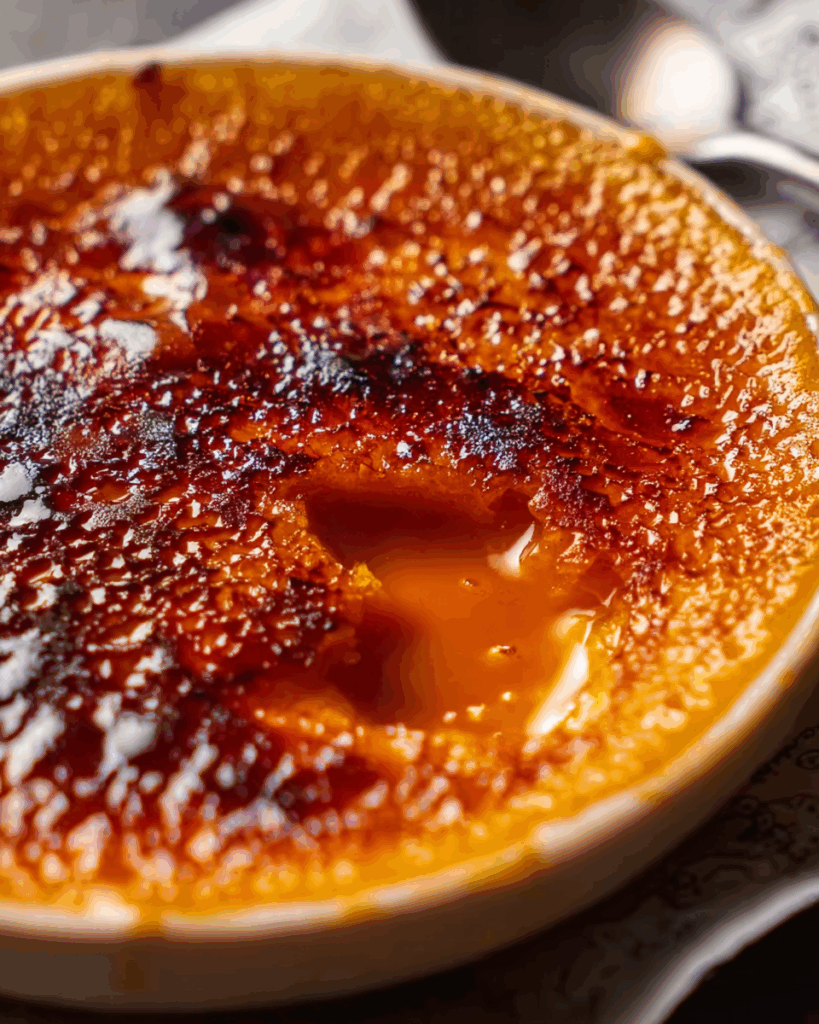
If you’ve ever ordered crème brûlée boba tea at a trendy café, you might be wondering—how does that drink relate to Thai Tea Crème Brûlée, the elegant, baked dessert? While they may share similar names and flavors, these two treats are very different in texture, preparation, and experience.
Let’s break down the distinctions clearly.
What Is Crème Brûlée Boba Tea?
Crème brûlée boba tea is a cold drink made with milk tea and tapioca pearls, topped with a creamy foam or custard layer, and finished with a torched sugar topping to mimic the crisp layer of a classic crème brûlée. In the Thai tea version, the base tea is Thai iced tea.
The result is a sweet, layered drink with a rich, creamy top and chewy boba pearls at the bottom. It’s a fun, modern take on both tea and dessert—but it’s still very much a beverage.
How It Differs from Traditional Thai Tea Crème Brûlée
Here’s a side-by-side breakdown of the two:
| Feature | Thai Tea Crème Brûlée | Crème Brûlée Boba Tea |
|---|---|---|
| Form | Baked custard in ramekin | Iced drink in cup |
| Texture | Creamy custard + hard caramel top | Liquid tea + soft foam + chewy boba |
| Temperature | Served chilled with warm sugar crust | Served cold over ice |
| Sugar Topping | Real torched granulated sugar | Torched milk foam or sugar syrup |
| Serving Style | Spoon-fed dessert | Drink with wide straw |
| Preparation Time | Requires baking and chilling | Assembled and shaken |
Flavor Similarities
Despite their differences, both desserts highlight the signature Thai tea flavor—earthy, sweet, and slightly spicy. In each case, that bold tea taste is softened by cream and sugar to create a smooth flavor profile.
The caramelized topping is another link. In both cases, that slightly burnt sugar element adds depth and contrast, even if it’s executed differently.
Which One Should You Choose?
- If you’re in the mood for a refreshing treat on a hot day, crème brûlée boba tea is fun, chewy, and cool.
- If you want a decadent dessert to finish a meal, Thai Tea Crème Brûlée offers a more refined, rich, and spoonable experience.
One is casual and playful; the other is elegant and indulgent. The good news? You don’t have to pick just one.
Can You Combine Both?
Absolutely. Some creative bakers and chefs are starting to add boba pearls into crème brûlée ramekins, or top their Thai Tea Crème Brûlée with a thin foam layer before torching. This hybrid approach brings the best of both worlds into one dessert.
Whether you’re sipping or spooning, the Thai tea flavor delivers every time. But if you’re craving something that feels a little more indulgent, complex, and crafted, there’s no doubt: Thai Tea Crème Brûlée wins on depth, texture, and wow-factor.
Best Tea Pairings with Crème Brûlée
Crème brûlée, whether in its traditional vanilla form or infused with bold flavors like Thai tea, is a dessert that shines on its own—but the right tea pairing can elevate it even further. Tea not only complements the sweetness and creaminess of the custard but also brings balance and freshness between bites.
In this section, we’ll explore the most harmonious tea pairings for Thai Tea Crème Brûlée and explain why these combinations work so beautifully.
What Tea Goes Well with Crème Brûlée?
Let’s start with general pairings for crème brûlée, focusing on flavor contrast, texture balance, and aromatic harmony.
1. Jasmine Green Tea
With its delicate floral notes and light body, jasmine tea contrasts beautifully with the richness of crème brûlée. The soft perfume of jasmine cuts through the heavy cream and balances the caramelized sugar crust.
2. Earl Grey Tea
This black tea infused with bergamot citrus oil brings a slightly bitter, zesty edge that pairs well with the sweetness of the custard. The citrus aroma also enhances any vanilla or spice notes in the brûlée.
3. Oolong Tea
Oolong teas vary from light to heavily oxidized, offering versatility. A more roasted oolong works best with custard—it brings nutty and woody undertones that echo the caramelized sugar topping.
4. Matcha (Japanese Green Tea)
For a bold, grassy contrast, matcha is an exciting choice. The earthy flavor cuts through the creaminess and introduces a vibrant pop of umami, creating a modern, fusion-style pairing.
Best Pairing for Thai Tea Crème Brûlée
Now, when it comes to Thai Tea Crème Brûlée specifically, your pairing should either complement the intense Thai tea flavor or contrast it strategically.
1. Thai Iced Tea
Yes—pairing Thai Tea Crème Brûlée with chilled Thai iced tea creates a flavor echo that deepens the experience. The familiarity of the tea highlights the complexity of the infused custard. Opt for a lighter version of the drink to avoid overwhelming the palate.
2. Lemongrass Tea
A caffeine-free, herbal option with bright citrus notes. Lemongrass cuts through the richness and offers a clean finish. Its natural sweetness and zing make it an excellent contrast to the earthy Thai tea custard.
3. Chrysanthemum Tea
This floral tea is commonly served with Asian desserts. It’s naturally sweet and pairs well with creamy dishes, making it a surprising but effective companion for Thai Tea Crème Brûlée.
4. Genmaicha (Toasted Rice Green Tea)
The nutty, popcorn-like aroma of genmaicha complements the roasted sugar crust and offers an earthy counterbalance to the tea-infused custard. It’s an ideal pairing for those who want a warming, comforting flavor match.
Why These Teas Work
The key to pairing tea with Thai Tea Crème Brûlée lies in contrasting richness and enhancing subtle flavors. The custard itself is full of deep black tea tones, spices, and sweetness. Teas that are:
- Light and floral cleanse the palate between bites
- Citrusy and aromatic enhance the vanilla and caramel notes
- Earthy or roasted mirror the custard’s complexity without clashing
And if you’re feeling adventurous, a Thai tea dessert trio with crème brûlée, iced Thai tea, and a jasmine pairing is a flavorful journey you won’t forget.
Serving Tips for Pairing Success
- Serve tea hot or warm: Cold teas can dull your taste buds, while warm teas enhance flavor sensitivity.
- Use small, elegant cups: A delicate dessert deserves equally refined presentation.
- Avoid overly sweet teas: The dessert is already sweet. Keep your tea clean and balanced.
Thai Tea Crème Brûlée is already a showstopper. But when paired with the right tea, it becomes a complete experience—satisfying all five senses.
Thai Tea Crème Brûlée Variations
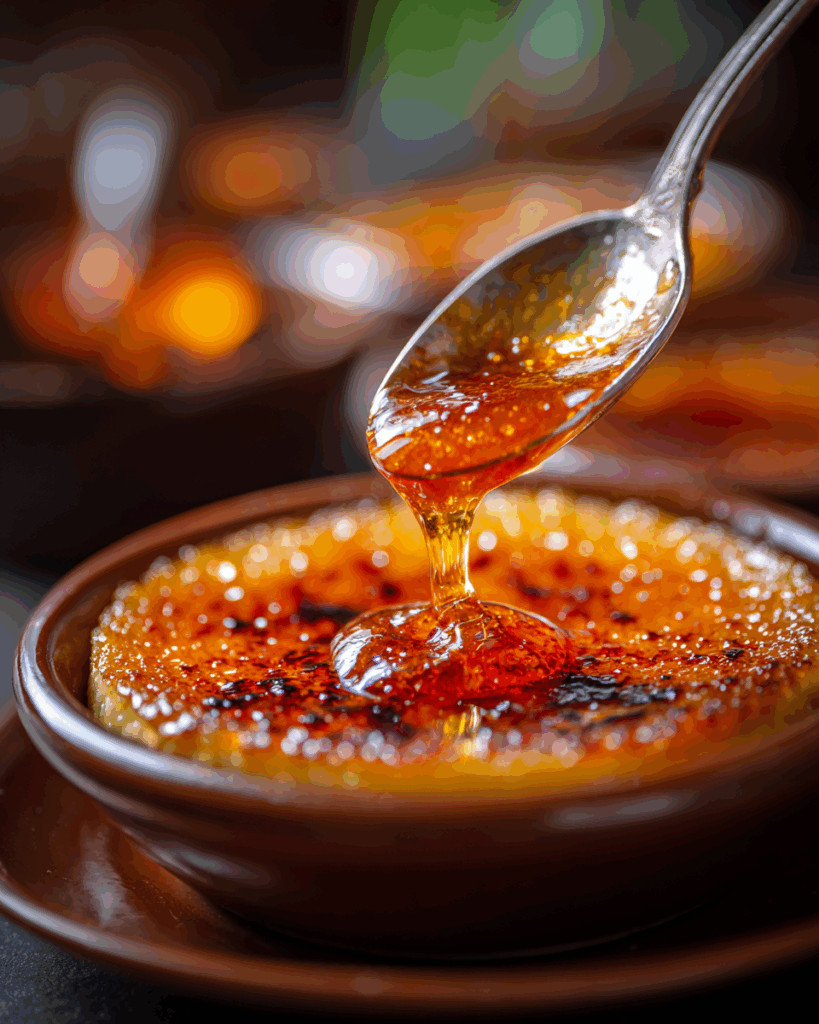
The beauty of Thai Tea Crème Brûlée lies in its versatility. While the classic baked custard version is irresistible on its own, there are countless ways to reinterpret the flavors, textures, and formats of this fusion dessert. Whether you’re in the mood for something playful like boba or want a more refined twist like pastry cream or caramel sauce, these variations allow you to adapt Thai Tea Crème Brûlée for any occasion.
Here are the most delicious and creative spins to try at home.
1. Thai Tea Crème Brûlée Boba
This variation combines the creamy custard elements of Thai Tea Crème Brûlée with the chewy delight of boba pearls. It’s dessert meets drink—served in layers or as a chilled fusion bowl.
How to Make It:
- Prepare the Thai tea custard as usual and chill it.
- Cook black tapioca pearls separately and soak them in a light Thai tea syrup or brown sugar.
- Layer pearls into the bottom of a clear glass or ramekin.
- Spoon the custard on top and chill again.
- Before serving, sprinkle with sugar and torch the top.
This version gives you the silky custard, the crack of brûlée, and the fun texture of boba—all in one bite.
2. Thai Tea Pastry Cream
Turn your Thai Tea Crème Brûlée base into a pastry cream to fill tarts, donuts, cream puffs, or éclairs. It’s perfect for anyone who loves Thai tea but prefers handheld desserts or filled pastries.
How to Adapt It:
- Steep Thai tea into whole milk or heavy cream, similar to the custard method.
- Use fewer eggs (typically 3 yolks per 2 cups of milk).
- Add cornstarch or flour to thicken on the stovetop.
- Chill and use in piping bags for filling.
This Thai tea pastry cream brings the same depth of flavor but adds a smooth, pipeable consistency ideal for bakeries or party platters.
3. Thai Tea Crème Brûlée Tart
Imagine a buttery tart crust filled with Thai tea-infused custard and topped with torched sugar. This is a showstopping dessert perfect for entertaining or special occasions.
How to Make It:
- Blind-bake a tart shell until golden.
- Pour Thai tea custard into the shell and bake gently (lower temperature to prevent curdling).
- Chill completely.
- Just before serving, add a thin layer of sugar and brûlée the top with a torch.
This variation offers texture contrast: crisp crust, creamy filling, and glassy caramel topping—all infused with Thai tea.
4. Thai Tea Crème Brûlée Recipe in Jars
If you want to serve your Thai Tea Crème Brûlée on the go or at events, make it in mason jars. These single-serve containers are portable, cute, and great for picnics or parties.
Key Tips:
- Fill jars just over halfway to allow for expansion.
- Bake uncovered in a water bath.
- Chill and cover with lids for transport.
- Torch sugar just before serving (keep a portable torch handy).
This version keeps your dessert fresh and stylish without sacrificing flavor or presentation.
5. Thai Tea Crème Brûlée Ice Cream
Turn your favorite custard into a creamy, scoopable ice cream infused with Thai tea and rippled with torched sugar bits.
What to Do:
- Make the same custard base but do not bake it.
- Chill thoroughly and churn in an ice cream maker.
- Fold in caramel shards or swirl in Thai tea caramel.
You get all the flavors of Thai Tea Crème Brûlée, but frozen, with pops of crunch and deep flavor complexity.
6. Thai Tea Caramel Topping
Want to upgrade your custard, coffee, or pancakes? Thai tea caramel is your answer. Inspired by the base of Thai Tea Crème Brûlée, this sauce takes the flavor and makes it pourable.
Recipe Idea:
- Steep Thai tea in cream as usual.
- Prepare a simple caramel with sugar and water, then stir in the steeped cream slowly.
- Cook until thick and pour over desserts, ice cream, or even a slice of cheesecake.
The result? A rich, golden, Thai tea caramel that’s floral, bold, and sweet with just a hint of bitterness.
7. Thai Tea Crème Brûlée Plant-Inspired Presentation
For a whimsical touch, present your Thai Tea Crème Brûlée in plant-inspired jars or mini pots, layering crushed cookies on top to mimic “soil” and topping with a mint sprig. This isn’t a flavor variation but a presentation twist that will impress guests.
Assembly Idea:
- Fill small ceramic pots with custard.
- Brûlée the sugar layer.
- Top with crushed chocolate cookies (like Oreo without filling).
- Add a small herb sprig (mint or Thai basil).
This playful look makes your Thai Tea Crème Brûlée feel fresh, Instagram-ready, and fun—perfect for themed parties or café menus.
From tarts and ice cream to boba blends and caramel toppings, these variations highlight just how versatile and exciting Thai Tea Crème Brûlée can be. Each offers a different way to enjoy the beloved Thai tea flavor with a new texture, format, or visual twist.
Serving, Storing, and Troubleshooting
Once you’ve gone through the effort of infusing, baking, and chilling your Thai Tea Crème Brûlée, the final steps—serving, storing, and handling common issues—can make or break your results. Let’s walk through exactly how to make this dessert shine, from the first crack of sugar to the last creamy bite.
How to Serve Thai Tea Crème Brûlée
Presentation is key when serving a dessert as elegant as Thai Tea Crème Brûlée. Here’s how to do it right:
1. Chill Before Serving
Your crème brûlée should be fully set and cold before serving. Refrigerate for at least 6 hours or overnight after baking to ensure a firm but silky custard.
2. Brûlée Just Before Serving
Never torch the sugar layer ahead of time. The sugar will soften and lose its crispness in the fridge. Wait until guests are ready, then:
- Sprinkle a thin, even layer of granulated sugar over the top.
- Use a kitchen torch to caramelize until deep amber and glassy.
- Let rest for 1–2 minutes so the sugar hardens.
3. Garnish for Extra Flair
For added presentation, top with:
- A sprig of Thai basil or mint
- A light dusting of Thai tea powder around the edge of the ramekin
- Edible flowers for a pop of color
Serve immediately with small dessert spoons to encourage savoring each bite.
Best Practices for Storing
To keep your Thai Tea Crème Brûlée fresh and safe to eat, follow these storage tips:
Refrigeration
- Store covered: Use plastic wrap or lids to prevent flavor absorption from other fridge items.
- Shelf life: Up to 3 days in the fridge before the texture starts to degrade.
- Do not brûlée before refrigerating—always do this step right before serving.
Can You Freeze Thai Tea Crème Brûlée?
Technically, yes—but it’s not recommended.
- Texture changes: Freezing can cause separation or icy crystals in the custard.
- Flavor loss: Thai tea’s delicate notes may dull after freezing.
If you must freeze it:
- Freeze without sugar topping.
- Wrap tightly in plastic and then foil.
- Thaw in the fridge overnight, then add and torch sugar.
Common Issues and How to Fix Them
Even experienced bakers run into challenges with crème brûlée. Here’s how to fix (or avoid) the most common problems.
1. Custard Is Runny After Baking
Problem: Undercooked or uneven baking.
Solution: Check your oven temp with a thermometer. Custards should wobble like Jell-O in the center. Bake in a hot water bath at 325°F for 35–40 minutes.
2. Eggy Taste
Problem: Overcooked or scrambled yolks.
Solution: Always temper your eggs slowly, and never boil the cream. Whisk constantly and bake gently to preserve flavor and texture.
3. Cracked Surface or Overbrowning
Problem: Oven too hot or baking without a water bath.
Solution: Always bake in a water bath to keep the custard’s surface moist. Cover ramekins loosely with foil if your oven runs hot.
4. Sugar Layer Isn’t Crisp
Problem: Too much sugar or incorrect torching.
Solution: Use fine granulated sugar in a thin layer. Torch slowly in circular motions until bubbling and golden brown.
5. Custard Has Bubbles or Grainy Texture
Problem: Overmixed or poured too fast into ramekins.
Solution: Pour custard through a fine mesh sieve and skim off any foam before baking.
Pro Tips for Consistently Great Results
- Don’t rush the steeping process: Let the Thai tea infuse for at least 20 minutes to capture its full aroma and color.
- Use a water bath every time: It’s non-negotiable for smooth custard.
- Torch with patience: Keep the flame moving and avoid burning the sugar or warming the custard too much.
Perfecting Thai Tea Crème Brûlée is all about precision and patience. When done right, it’s a show-stopping dessert that delivers flavor, texture, and visual wow in every bite.
Conclusion
Whether you’re drawn to the silky texture, the caramelized crunch, or the bold flavor of Thai tea, Thai Tea Crème Brûlée is a dessert that satisfies on every level. It’s more than a sweet treat—it’s a cultural blend that combines the finesse of French baking with the aromatic power of Thailand’s most iconic tea.
From classic ramekin-baked versions to creative variations like Thai tea boba custards, pastry creams, and even Thai tea caramel, this dessert proves it can be as adaptable as it is delicious. With the tips, techniques, and pairings you’ve explored throughout this article, you’re now fully equipped to master this unforgettable dessert in your own kitchen.
Don’t miss our next Thai dessert feature, or if you loved this, try our Thai Coconut Custard or Red Rubies Dessert next. Every spoonful you try brings you one step closer to the flavors of Thailand.
Frequently Asked Questions (FAQs)
What are the ingredients in crème brûlée tea?
If you come across crème brûlée tea in loose leaf or packaged form, it typically refers to a flavored black tea that mimics the notes of the dessert. Ingredients may include:
Black tea leaves
Vanilla essence
Caramel flavoring
Natural cream flavor
Sometimes even toasted sugar pieces for aroma
For Thai versions, it may include Thai tea mix, which contains Ceylon or Assam black tea, star anise, crushed tamarind, and orange food coloring, combined with sweeteners or creamy essences.
You can even make your own “crème brûlée tea” at home by steeping Thai tea in heavy cream, as done in the recipe for Thai Tea Crème Brûlée, and adding sugar or milk to taste.
What is crème brûlée boba tea?
Crème brûlée boba tea is a modern, trendy drink that mimics the classic dessert. It typically features:
A base of Thai milk tea or black milk tea
A layer of sweetened cream or custard-like foam on top
Tapioca pearls (boba) at the bottom
A caramelized sugar top, torched or pre-caramelized, for the “brûlée” effect
It’s served cold with a wide straw so you can sip the layers and chew the boba simultaneously. While it’s inspired by the baked version, it’s fundamentally a drink, not a custard-based dessert.
What is the cream in Thai tea?
In the traditional drink version, Thai tea is often finished with evaporated milk, sweetened condensed milk, or even coconut milk to create that smooth, rich texture and orange hue.
For Thai Tea Crème Brûlée, the cream refers specifically to heavy cream that’s infused with Thai tea. This substitution adds a thicker consistency and helps set the custard properly when baked. The result is richer and silkier than the beverage version, but with all the bold Thai tea flavor intact.
What tea goes well with crème brûlée?
Tea pairings depend on the flavor of your crème brûlée. With traditional vanilla crème brûlée, jasmine green tea, Earl Grey, or a lightly roasted oolong tea are excellent choices. These teas balance out the richness of the custard and enhance the caramelized sugar top.
For Thai Tea Crème Brûlée, the best tea to pair is the same Thai tea mix used in the dessert itself. This creates a harmonious flavor echo between what you sip and what you eat. Alternatively, try lemongrass tea or chrysanthemum tea for a light, floral contrast that won’t overpower the custard.

